Jong Chul Ye
Extreme Blind Image Restoration via Prompt-Conditioned Information Bottleneck
Oct 01, 2025
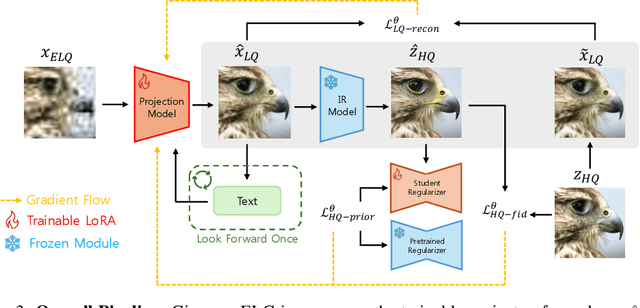

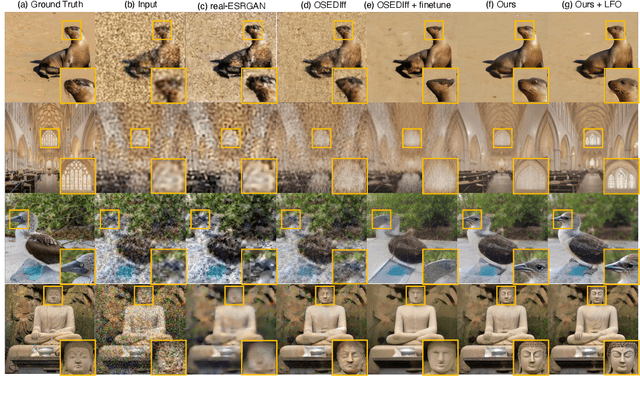
Abstract:Blind Image Restoration (BIR) methods have achieved remarkable success but falter when faced with Extreme Blind Image Restoration (EBIR), where inputs suffer from severe, compounded degradations beyond their training scope. Directly learning a mapping from extremely low-quality (ELQ) to high-quality (HQ) images is challenging due to the massive domain gap, often leading to unnatural artifacts and loss of detail. To address this, we propose a novel framework that decomposes the intractable ELQ-to-HQ restoration process. We first learn a projector that maps an ELQ image onto an intermediate, less-degraded LQ manifold. This intermediate image is then restored to HQ using a frozen, off-the-shelf BIR model. Our approach is grounded in information theory; we provide a novel perspective of image restoration as an Information Bottleneck problem and derive a theoretically-driven objective to train our projector. This loss function effectively stabilizes training by balancing a low-quality reconstruction term with a high-quality prior-matching term. Our framework enables Look Forward Once (LFO) for inference-time prompt refinement, and supports plug-and-play strengthening of existing image restoration models without need for finetuning. Extensive experiments under severe degradation regimes provide a thorough analysis of the effectiveness of our work.
Align Your Tangent: Training Better Consistency Models via Manifold-Aligned Tangents
Oct 01, 2025Abstract:With diffusion and flow matching models achieving state-of-the-art generating performance, the interest of the community now turned to reducing the inference time without sacrificing sample quality. Consistency Models (CMs), which are trained to be consistent on diffusion or probability flow ordinary differential equation (PF-ODE) trajectories, enable one or two-step flow or diffusion sampling. However, CMs typically require prolonged training with large batch sizes to obtain competitive sample quality. In this paper, we examine the training dynamics of CMs near convergence and discover that CM tangents -- CM output update directions -- are quite oscillatory, in the sense that they move parallel to the data manifold, not towards the manifold. To mitigate oscillatory tangents, we propose a new loss function, called the manifold feature distance (MFD), which provides manifold-aligned tangents that point toward the data manifold. Consequently, our method -- dubbed Align Your Tangent (AYT) -- can accelerate CM training by orders of magnitude and even out-perform the learned perceptual image patch similarity metric (LPIPS). Furthermore, we find that our loss enables training with extremely small batch sizes without compromising sample quality. Code: https://github.com/1202kbs/AYT
Generalizable Holographic Reconstruction via Amplitude-Only Diffusion Priors
Sep 16, 2025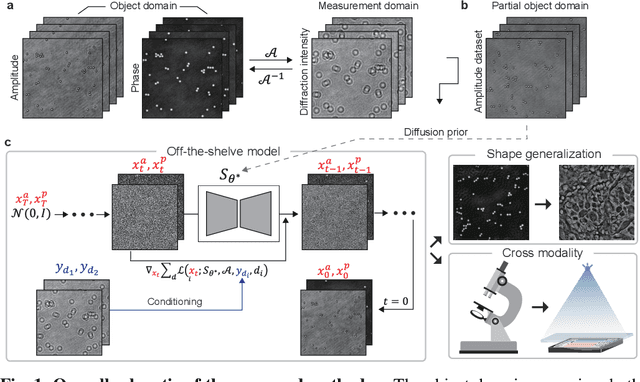
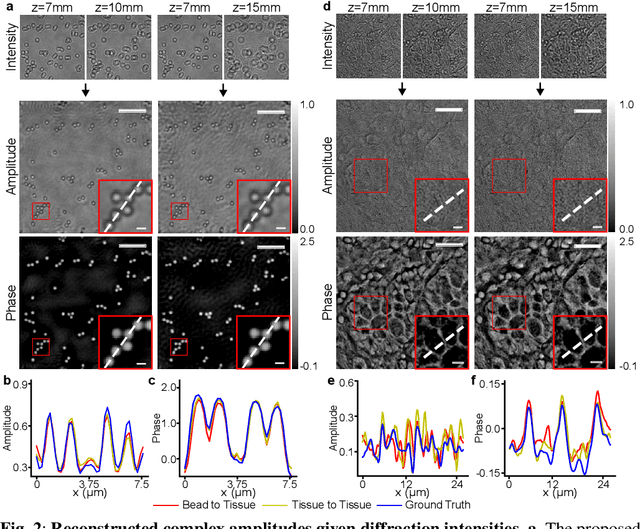
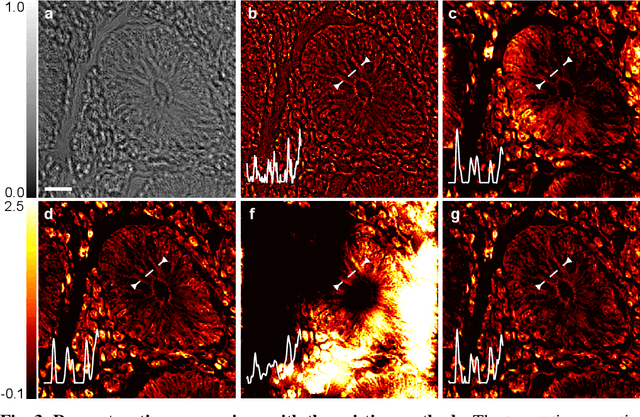
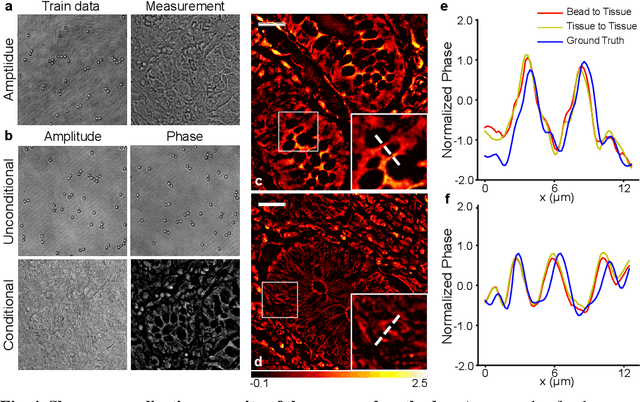
Abstract:Phase retrieval in inline holography is a fundamental yet ill-posed inverse problem due to the nonlinear coupling between amplitude and phase in coherent imaging. We present a novel off-the-shelf solution that leverages a diffusion model trained solely on object amplitude to recover both amplitude and phase from diffraction intensities. Using a predictor-corrector sampling framework with separate likelihood gradients for amplitude and phase, our method enables complex field reconstruction without requiring ground-truth phase data for training. We validate the proposed approach through extensive simulations and experiments, demonstrating robust generalization across diverse object shapes, imaging system configurations, and modalities, including lensless setups. Notably, a diffusion prior trained on simple amplitude data (e.g., polystyrene beads) successfully reconstructs complex biological tissue structures, highlighting the method's adaptability. This framework provides a cost-effective, generalizable solution for nonlinear inverse problems in computational imaging, and establishes a foundation for broader coherent imaging applications beyond holography.
Improving Video Diffusion Transformer Training by Multi-Feature Fusion and Alignment from Self-Supervised Vision Encoders
Sep 11, 2025Abstract:Video diffusion models have advanced rapidly in the recent years as a result of series of architectural innovations (e.g., diffusion transformers) and use of novel training objectives (e.g., flow matching). In contrast, less attention has been paid to improving the feature representation power of such models. In this work, we show that training video diffusion models can benefit from aligning the intermediate features of the video generator with feature representations of pre-trained vision encoders. We propose a new metric and conduct an in-depth analysis of various vision encoders to evaluate their discriminability and temporal consistency, thereby assessing their suitability for video feature alignment. Based on the analysis, we present Align4Gen which provides a novel multi-feature fusion and alignment method integrated into video diffusion model training. We evaluate Align4Gen both for unconditional and class-conditional video generation tasks and show that it results in improved video generation as quantified by various metrics. Full video results are available on our project page: https://align4gen.github.io/align4gen/
FlowAlign: Trajectory-Regularized, Inversion-Free Flow-based Image Editing
May 29, 2025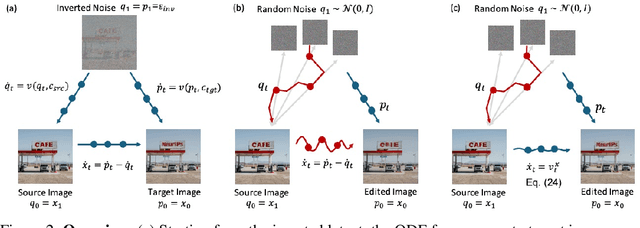

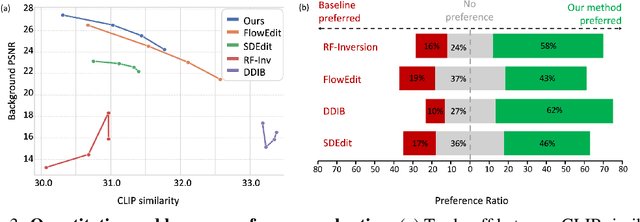

Abstract:Recent inversion-free, flow-based image editing methods such as FlowEdit leverages a pre-trained noise-to-image flow model such as Stable Diffusion 3, enabling text-driven manipulation by solving an ordinary differential equation (ODE). While the lack of exact latent inversion is a core advantage of these methods, it often results in unstable editing trajectories and poor source consistency. To address this limitation, we propose FlowAlign, a novel inversion-free flow-based framework for consistent image editing with principled trajectory control. FlowAlign introduces a flow-matching loss as a regularization mechanism to promote smoother and more stable trajectories during the editing process. Notably, the flow-matching loss is shown to explicitly balance semantic alignment with the edit prompt and structural consistency with the source image along the trajectory. Furthermore, FlowAlign naturally supports reverse editing by simply reversing the ODE trajectory, highlighting the reversible and consistent nature of the transformation. Extensive experiments demonstrate that FlowAlign outperforms existing methods in both source preservation and editing controllability.
Universal Reasoner: A Single, Composable Plug-and-Play Reasoner for Frozen LLMs
May 25, 2025Abstract:Large Language Models (LLMs) have demonstrated remarkable general capabilities, but enhancing skills such as reasoning often demands substantial computational resources and may compromise their generalization. While Parameter-Efficient Fine-Tuning (PEFT) methods offer a more resource-conscious alternative, they typically requires retraining for each LLM backbone due to architectural dependencies. To address these challenges, here we propose Universal Reasoner (UniR) - a single, lightweight, composable, and plug-and-play reasoning module that can be used with any frozen LLM to endow it with specialized reasoning capabilities. Specifically, UniR decomposes the reward into a standalone reasoning module that is trained independently using predefined rewards, effectively translating trajectory-level signals into token-level guidance. Once trained, UniR can be combined with any frozen LLM at inference time by simply adding its output logits to those of the LLM backbone. This additive structure naturally enables modular composition: multiple UniR modules trained for different tasks can be jointly applied by summing their logits, enabling complex reasoning via composition. Experimental results on mathematical reasoning and machine translation tasks show that UniR significantly outperforms \add{existing baseline fine-tuning methods using the Llama3.2 model}. Furthermore, UniR demonstrates strong weak-to-strong generalization: reasoning modules trained on smaller models effectively guide much larger LLMs. This makes UniR a cost-efficient, adaptable, and robust solution for enhancing reasoning in LLMs without compromising their core capabilities. Code is open-sourced at https://github.com/hangeol/UniR
Chain-of-Zoom: Extreme Super-Resolution via Scale Autoregression and Preference Alignment
May 24, 2025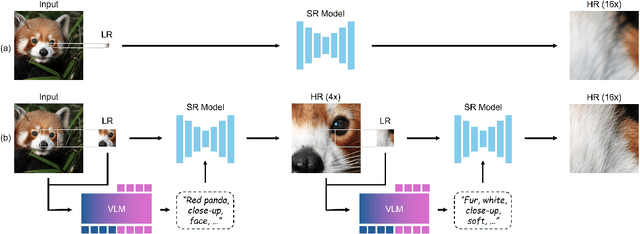
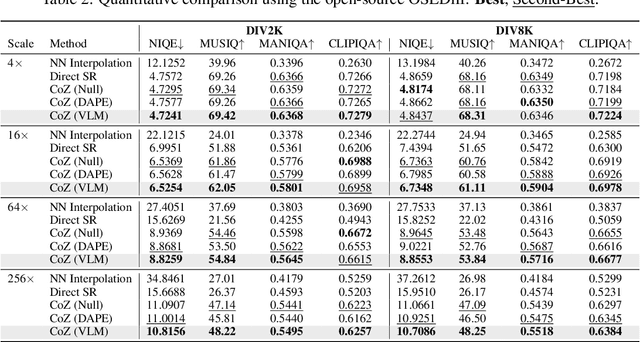
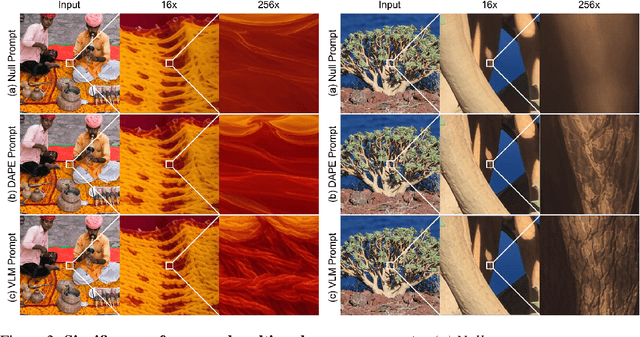

Abstract:Modern single-image super-resolution (SISR) models deliver photo-realistic results at the scale factors on which they are trained, but collapse when asked to magnify far beyond that regime. We address this scalability bottleneck with Chain-of-Zoom (CoZ), a model-agnostic framework that factorizes SISR into an autoregressive chain of intermediate scale-states with multi-scale-aware prompts. CoZ repeatedly re-uses a backbone SR model, decomposing the conditional probability into tractable sub-problems to achieve extreme resolutions without additional training. Because visual cues diminish at high magnifications, we augment each zoom step with multi-scale-aware text prompts generated by a vision-language model (VLM). The prompt extractor itself is fine-tuned using Generalized Reward Policy Optimization (GRPO) with a critic VLM, aligning text guidance towards human preference. Experiments show that a standard 4x diffusion SR model wrapped in CoZ attains beyond 256x enlargement with high perceptual quality and fidelity.
Guided Diffusion Sampling on Function Spaces with Applications to PDEs
May 22, 2025Abstract:We propose a general framework for conditional sampling in PDE-based inverse problems, targeting the recovery of whole solutions from extremely sparse or noisy measurements. This is accomplished by a function-space diffusion model and plug-and-play guidance for conditioning. Our method first trains an unconditional discretization-agnostic denoising model using neural operator architectures. At inference, we refine the samples to satisfy sparse observation data via a gradient-based guidance mechanism. Through rigorous mathematical analysis, we extend Tweedie's formula to infinite-dimensional Hilbert spaces, providing the theoretical foundation for our posterior sampling approach. Our method (FunDPS) accurately captures posterior distributions in function spaces under minimal supervision and severe data scarcity. Across five PDE tasks with only 3% observation, our method achieves an average 32% accuracy improvement over state-of-the-art fixed-resolution diffusion baselines while reducing sampling steps by 4x. Furthermore, multi-resolution fine-tuning ensures strong cross-resolution generalizability. To the best of our knowledge, this is the first diffusion-based framework to operate independently of discretization, offering a practical and flexible solution for forward and inverse problems in the context of PDEs. Code is available at https://github.com/neuraloperator/FunDPS
Physics-guided and fabrication-aware inverse design of photonic devices using diffusion models
Apr 23, 2025Abstract:Designing free-form photonic devices is fundamentally challenging due to the vast number of possible geometries and the complex requirements of fabrication constraints. Traditional inverse-design approaches--whether driven by human intuition, global optimization, or adjoint-based gradient methods--often involve intricate binarization and filtering steps, while recent deep learning strategies demand prohibitively large numbers of simulations (10^5 to 10^6). To overcome these limitations, we present AdjointDiffusion, a physics-guided framework that integrates adjoint sensitivity gradients into the sampling process of diffusion models. AdjointDiffusion begins by training a diffusion network on a synthetic, fabrication-aware dataset of binary masks. During inference, we compute the adjoint gradient of a candidate structure and inject this physics-based guidance at each denoising step, steering the generative process toward high figure-of-merit (FoM) solutions without additional post-processing. We demonstrate our method on two canonical photonic design problems--a bent waveguide and a CMOS image sensor color router--and show that our method consistently outperforms state-of-the-art nonlinear optimizers (such as MMA and SLSQP) in both efficiency and manufacturability, while using orders of magnitude fewer simulations (approximately 2 x 10^2) than pure deep learning approaches (approximately 10^5 to 10^6). By eliminating complex binarization schedules and minimizing simulation overhead, AdjointDiffusion offers a streamlined, simulation-efficient, and fabrication-aware pipeline for next-generation photonic device design. Our open-source implementation is available at https://github.com/dongjin-seo2020/AdjointDiffusion.
InvFussion: Bridging Supervised and Zero-shot Diffusion for Inverse Problems
Apr 02, 2025



Abstract:Diffusion Models have demonstrated remarkable capabilities in handling inverse problems, offering high-quality posterior-sampling-based solutions. Despite significant advances, a fundamental trade-off persists, regarding the way the conditioned synthesis is employed: Training-based methods achieve high quality results, while zero-shot approaches trade this with flexibility. This work introduces a framework that combines the best of both worlds -- the strong performance of supervised approaches and the flexibility of zero-shot methods. This is achieved through a novel architectural design that seamlessly integrates the degradation operator directly into the denoiser. In each block, our proposed architecture applies the degradation operator on the network activations and conditions the output using the attention mechanism, enabling adaptation to diverse degradation scenarios while maintaining high performance. Our work demonstrates the versatility of the proposed architecture, operating as a general MMSE estimator, a posterior sampler, or a Neural Posterior Principal Component estimator. This flexibility enables a wide range of downstream tasks, highlighting the broad applicability of our framework. The proposed modification of the denoiser network offers a versatile, accurate, and computationally efficient solution, demonstrating the advantages of dedicated network architectures for complex inverse problems. Experimental results on the FFHQ and ImageNet datasets demonstrate state-of-the-art posterior-sampling performance, surpassing both training-based and zero-shot alternatives.
 Add to Chrome
Add to Chrome Add to Firefox
Add to Firefox Add to Edge
Add to Edge